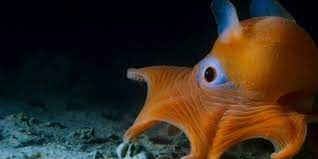This suborder belongs to some of the strangest of the octopoda, including the flapjack, dumbo and cirrothauma species. They are characterised by the hair like structures on their suckers called 'cirri'. Although we don't know what their function is, its thought to be an enhanced way of detecting close-by prey.
Cirrate octopuses also have an internal shell in their mantle made of calcium carbonate. The shell helps support swimming and keeping the structure of the body in the high pressures of deep water which would otherwise be difficult without any bones!
It is also thought that some female octopuses will keep their eggs in the shelled mantle to protect them until they hatch.
Female cirrates - unlike female incirrates who die after pregnancy - are always pregnant once they reach sexual maturity as she collects the sex arms of males and stores them to fertilise her eggs whenever she wants to. This is beneficial as she will never know when she'll find her next mate in the open sea. No one has ever seen cirrates mating - there is still a lot to learn about them.
Cirrates additionally lack an ink sac. These octopuses live in the mesopelagic and bathypelagic ocean zones so a very limited percentage of sunlight reaches this area: approximately 0% - 20% of that humans receive. Therefore, dispersing ink in an already dark environment won't deter the predator hunting them since creatures inhabiting the deep are well adapted to the pitch black. This means cirrates have no need for the ink sac. The greatest depth a cirrate octopus has ever been found is 7,000m below the surface which is well into the hadalpelagic zone.
Perhaps the most identifiable trait of a cirrate octopus is the two fins that support swimming. These are normally attached to the mantle, internal shell, or both.
When you think of an octopus, you're likely to imagine one of these. They lack fins, have an ink sac, and are more likely to be benthic than pelagic (an exception is the blanket octopus).
Unfortunately, incirrates are semelparous, so die after pregnancy. This means they only lay one clutch of eggs in their lifetimes.
This suborder mainly lives in the epipelagic and upper mesopelagic sea zones which recieves 20% - 100% of the sunlight humans do. However, the deepest an incirrate octopus has been found is 2,394m below the surface. It remained unidentified but is suspected to be the ghost octopus.
Above, the ghost octopus, discovered in 2016 and remaining unfully classified. Those who discovered him named him 'Casper' after his ghoulish appearance.
Examples of incirrates are the common octopus, the mimic octopus and the coconut octopus.
REFERENCES
Incirrate vs Cirrate Octopuses: What's the Difference?
OctoNation
(Year Unknown)
World's Deepest Octopus Captured on Camera
Jonathan Amos - BBC
May 2020
Newly Discovered 'Casper' Octopus
Cell Press
2016
Date Published: 19th July 2023
Date Reviewed: 15th December 2023




No comments:
Post a Comment